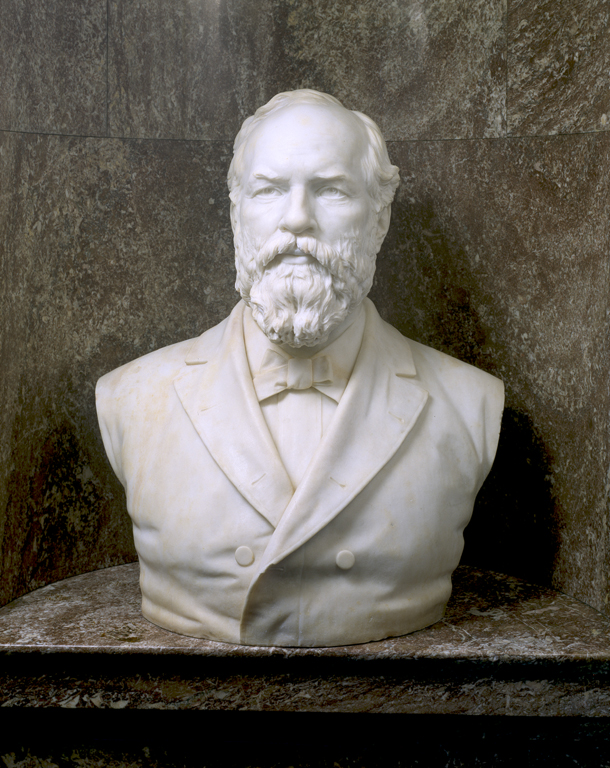
| Title | James A. Garfield |
| Artist/Maker | Charles Henry Niehaus ( 1855 - 1935 ) |
| Date | 1885 ca. |
| Medium | Marble |
| Dimensions | h. 30.25 x w. 24.38 x d. 18.25 in. (h. 76.8 x w. 61.9 x d. 46.4 cm) |
| Credit Line | U.S. Senate Collection |
| Accession Number | 21.00011.000 |
In 1965 Marie J. Niehaus, daughter of sculptor Charles Niehaus, bequeathed her father’s bust of President James Garfield to the United States. She asked that the piece be displayed in the President’s Room of the U.S. Capitol, along with the bust of President William McKinley, already in the room. The Joint Committee on the Library accepted the Garfield bust as a gift from the Niehaus estate.
Born in Cincinnati, Ohio, and trained in his home state and at Munich’s Royal Academy, Niehaus was Cincinnati’s logical choice to create the city’s memorial to the slain president following Garfield’s death in 1881. The resulting standing figure of Garfield, modeled in 1883 as Niehaus’s first commission, led immediately to commissions for Ohio’s two contributions to the National Statuary Hall Collection in the U.S. Capitol: Garfield and former governor William Allen.
Marie Niehaus stated that her father executed the Senate’s bust of Garfield at the same time as his full-length sculptures of the president. Lucretia Garfield, the widowed first lady, is said to have consulted on the modeling of the works.
After the Garfield commissions, Niehaus primarily worked abroad in a Rome studio. In 1892 he executed a particularly noteworthy pair of bronze relief doors for New York City’s Trinity Church, and in 1893 he exhibited with distinction at the World’s Columbian Exposition in Chicago. Niehaus is represented today by 10 sculptural pieces in the U.S. Capitol; the Senate’s busts of Garfield and Vice President Daniel D. Tompkins are among them. His public sculptures are located in numerous cities in the United States.
A U.S. representative from Ohio and 20th president of the United States, James Abram Garfield was born near Orange, Ohio. Before entering political life, Garfield was a professor at Western Reserve Eclectic Institute (now Hiram College) and served as its president from 1857 to 1861. Elected to the Ohio senate as a Republican in 1859, he gained popularity as a persuasive speaker in support of abolition. During the Civil War, Garfield joined the Union army, performed courageously in battle, and rose to the rank of major general before resigning in 1863. He then served in the U.S. House of Representatives from 1863 to 1880. An opponent of currency inflation and excessive tariffs, Garfield was chosen House minority leader in 1876. The following year he played a key role in the election of President Rutherford B. Hayes by serving on the electoral commission that ruled on contested ballots from several states.
Although elected to the U.S. Senate in 1880, Garfield never took his seat. Following a lengthy deadlock at the Republican convention, he was unanimously nominated for the presidency as a compromise candidate. He won the election but served as president for only four months. Garfield was fatally shot at the Pennsylvania Railroad depot in Washington, D.C., by Charles Guiteau, a disappointed office seeker. Public outrage over the loss of President Garfield, who lingered for 11 weeks before dying, led to the creation of the Civil Service system to manage U.S. government employment more effectively.